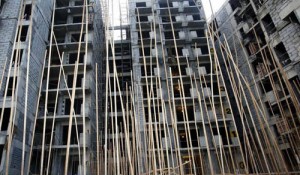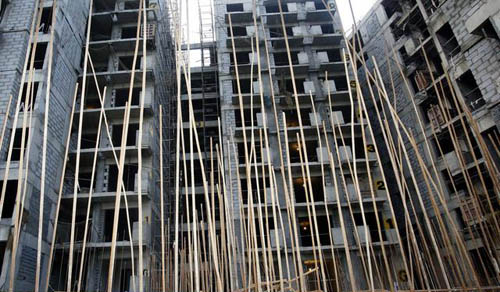Bottom Line: Project launches targeted at EWS by private developers remained negligible across the top 7 cities.
 ‘Housing For All by 2022: A Reality Check, a joint study released by Megalith Ventures and Meraqi, highlights the critical aspects of urban housing shortage in Indian cities in Economically Weaker Section (EWS) and Lower Income Group (LIG) segment, assesses the status of various Government announced initiatives and interventions and analyses the impact on ground in terms of private sector participation across the top 7 cities.
‘Housing For All by 2022: A Reality Check, a joint study released by Megalith Ventures and Meraqi, highlights the critical aspects of urban housing shortage in Indian cities in Economically Weaker Section (EWS) and Lower Income Group (LIG) segment, assesses the status of various Government announced initiatives and interventions and analyses the impact on ground in terms of private sector participation across the top 7 cities.
Housing Shortage in the urban areas is particularly high in Economically Weaker Sections (EWS) at 10 million units, followed by 7.4 million units in Lower Income Group (LIG).Until now, Central assistance to the tune of INR 13,583 Crore has been released and Interest subsidy of INR 1,859 Crore has been credited. Under the PMAY(U) scheme ( as per 8thJuly 2018 release by Ministry of Housing and Urban Poverty Alleviation, Government of India), 51 lakh units have been approved, 28 lakh units have been grounded and only 8 lakh units have been completed.
According to the report, in- spite of detailing out the Public Private Partnership model, the housing shortage in EWS has been only catered by the Urban Local Bodies and Parastatal Agencies. Most of the projects launched by the private developers across the major cities were focused on young, urban dwellers.
Especially, in top 7 residential markets, developers have mostly focused on lowering the unit sizes to comply with the minimum unit area requirement or ensured 35% of the units in EWS category to avail the tax benefits and kept the base ticket price at INR 35 Lakhs within the eligibility range of housing loan limits under Private Sector Lending.
Explaining the reason behind the reluctance of private players entering EWS housing segment, Gorakh Jhunjhunwala, Managing Director, Meraqi says“the incentives announced by the Central Government are not sufficient trade-offs to allure private developers to Affordable Housing segment. Lack of suitable land parcels, high land cost in economic centres, rising construction costs and low profit margins are limiting private sector participation.”
Giving further insight into Bangalore’s residential market, Jhunjhunwala adds “In Bangalore city, private developers have launched only 10,384 units in less than 60 sqm carpet area and the base ticket prices are not less than INR 10 lacs. As there is no upper limit on the ticket prices for affordable housing, projects have been launched closer to economic hubs targeted at LIG and MIG segments. The primary reason being the inconsistency in affordable housing policies formulated by the State Government and the Central Government which is creating a major impediment in employing the benefits of GoI schemes. There has to be clarity on additional FAR, TDR & density norms as incentives for development of affordable housing projects.”
The report further highlights some of the key measures to be considered by the Government and implementing agencies to ensure increased participation of private sector in the development of affordable housing projects. “Earmarking dedicated zones for the development of affordable housing in a city’s master plan, more emphasis on in situ upgradation, formulating rental housing model policy, unlocking the land parcels and providing higher FSI and accessibility of construction finance are absolutely imperative to fulfil the target of ‘Housing For All by 2022’ says Jhunjhunwala.
The report also reveals that affordable housing segment is all set to witness increased absorption in the coming years due to the revision by RBI in housing loan limits under Private Sector Lending (PSL) from INR 28 Lakhs to INR 35 Lakhs in metropolitan cities – cost not exceeding INR 45 Lakhs.
The sector is also expected to get an additional boost as PE & NBFC into Affordable housing segment is on an upward trajectory. “During H1 2018, 25% of the total residential inflows by PE and NBFCs was in the affordable housing sector” says Mallanna Sasalu, Director, Megalith Ventures. “Going forward, the Buy and Sell model will be gaining significance particularly post restrictive covenants in RERA regarding diversion of project funds – 70% of the sale proceeds to be invested in the project. Simultaneously, rental model will gain interest as developers can opt for the model and devise the mix of units by allocating few blocks in a project for rental housing or even the entire project.” adds Sasalu.
Key highlights from the report:
Housing shortage in urban areas is particularly high in the Economically Weaker Section at 10 million units and 7.4 million units in the Lower Income Group.
Since the launch of PMAY (U) in 2015, 51.07 lakh houses have been approved, 28 lakh houses have been grounded and 8 lakh units have been completed.
Affordable Housing in Partnership (AHP) projects were mostly launched on the land of Urban Local Bodies and Parastatal Agencies.
Across the top 7 cities, project launches by the private developer have been primarily in less than INR 26 Lakhs price segment targeted at LIG and MIG.
There has been a serious lack of interest from the most crucial stakeholders – private sector for development of Affordable Housing in Partnership on PPP basis primarily due to incongruity between state and central policies.
Post PMAY, only 10,384 units were launched by private developers in Bangalore in <60 sqm carpet area. However, these projects were not targeted at the EWS segment.
3,732 units were launched by Grade A developers with unit sizes of < 60 sqm carpet area post PMAY announcement – 53 percentage point increase compared to pre-PMAY period. Proportion of launches with units of carpet area < 60 sqm to total launches by Grade A developers increased from an average of 3.5% (2012-2014) to 9.1% in post PMAY.
It is also necessary to synchronize State & Central level Policies and to integrate them with the city’s master plan. This will help streamline approval processes at the city level.
The approval processes need to be streamlined with a Single window approval for projects. Capacity of developers also needs to be enhanced with access to best practices/models adopted in low cost construction/modular technologies.





